Secret Chamber? Cosmic Rays Reveal Possible Void Inside Great Pyramid
Secret Chamber? Cosmic Rays Reveal Possible Void Inside Great Pyramid

A large void has been discovered inside the Great Pyramid of Giza, thanks to cosmic rays. If the large space turns out to exist, its function — which could be anything from new chamber to sealed-off construction passage — is likely to be the source of much archaeological debate.
An international group of researchers reported today (Nov. 2) in the journal Nature that by tracking the movements of particles called muons, they have found an empty space more than 98 feet (30 meters) long that sits right above the granite-walled Grand Gallery within the massive pyramid. The Great Pyramid, also known as Khufu’s pyramid, was built during that pharaoh’s reign between 2509 B.C. and 2483 B.C. No new rooms or passages have been confirmed inside the pyramid since the 1800s.
“The void is there,” said Mehdi Tayoubi, the president of the organization Heritage Innovation Preservation and a leader of the ScanPyramids mission, an ongoing effort to bring new technology to bear on Egypt’s most famous structures. Read more.
More Posts from Xyhor-astronomy and Others








TODAY IN HISTORY: Behold these beautiful shots of the Earth taken from the Gemini 5 spacecraft on August 25, 1965.
(NASA/ASU)
The Xpand Your Horizons Family just got bigger! Check out the new pages!
Xpand Your Horizons w/ Paleontology: https://m.youtube.com/playlist?list=PLHFUouhBXdXF6kf0dbsVRghNyDzscVcKc
xyhor-paleontology: https://xyhor-paleontology.tumblr.com
Xpand Your Horizons w/ Archaeology: https://m.youtube.com/playlist?list=PLHFUouhBXdXF6kf0dbsVRghNyDzscVcKc
xyhor-archaeology: https://xyhor-archaeology.tumblr.com
Don’t forget to check out the rest of the family too: https://xpandyourhorizons.tumblr.com/xyhor-family
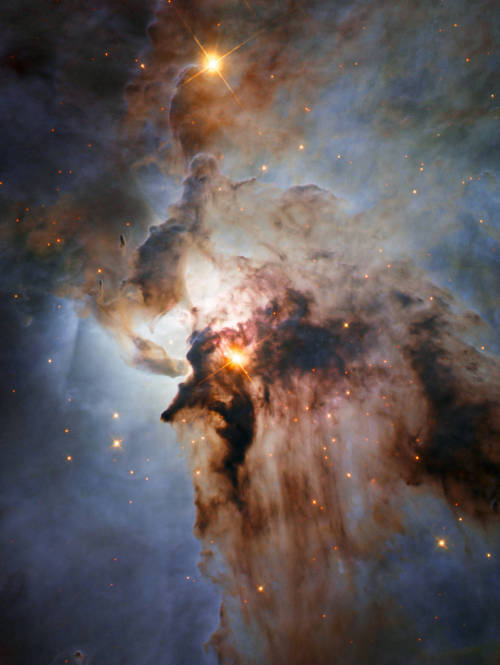
Stormy Seas in Sagittarius
This new NASA/ESA Hubble Space Telescope image shows the center of the Lagoon Nebula, an object with a deceptively tranquil name, in the constellation of Sagittarius. The region is filled with intense winds from hot stars, churning funnels of gas, and energetic star formation, all embedded within an intricate haze of gas and pitch-dark dust.
Image Credit: NASA/JPL/ESA/J. Trauger
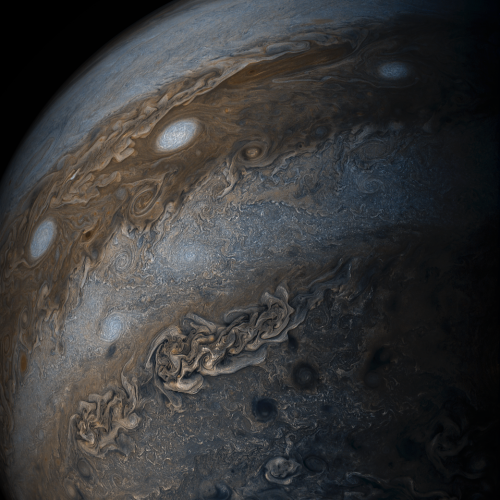
Jupiter’s Bands of Clouds
This enhanced-color image of Jupiter’s bands of light and dark clouds was created by citizen scientists Gerald Eichstädt and Seán Doran using data from the JunoCam imager on NASA’s Juno spacecraft.
Three of the white oval storms known as the “String of Pearls” are visible near the top of the image. Each of the alternating light and dark atmospheric bands in this image is wider than Earth, and each rages around Jupiter at hundreds of miles (kilometers) per hour. The lighter areas are regions where gas is rising, and the darker bands are regions where gas is sinking.
Credits: NASA/JPL-Caltech/SwRI/MSSS/Gerald Eichstädt /Seán Doran









5 Questions You Were Too Embarrassed To Ask About The Expanding Universe
“5.) Are there galaxies moving away faster than the speed of light, and isn’t that forbidden? From our point of view, the space in between us and any distant point is expanding. The farther away something is, the faster it appears to recede from us. Even if the expansion rate were tiny, an object far enough away would eventually cross that threshold of any finite speed, since an expansion rate (a speed-per-distance) multiplied by a great enough distance will give you a speed as fast as you want. But this is okay in General Relativity! The law that nothing can travel faster than the speed of light only applies to an object’s motion through space, not to the expansion of space itself. In reality, the galaxies themselves only move around at speeds that are hundreds or thousands of km/s, much lower than the 300,000 km/s speed limit set by the speed of light. It’s the expansion of the Universe that causes this recession and the redshift, not a true galactic motion.”
The idea that the spatial fabric of the Universe itself is expanding, and that’s what’s behind the observed relationship between redshift and distance has long been controversial, and also long-misunderstood. After all, if more distant objects appear to recede more quickly, couldn’t there be a different explanation, like an explosion that flung many things outward? As it turns out, this isn’t a mere difference in interpretation, there are observations we can make that tell us the answer! The Universe is not expanding ‘into’ anything, despite what your intuition might tell you. The Hubble ‘constant’ isn’t actually a constant, but is rather decreasing as time goes on. The Universe looks like it’s going to expand forever, but even that scientific conclusion is subject to revision depending on what data shows in the future. And although 97% of the galaxies in the Universe are already unreachable, it isn’t a violation of relativity or a faster-than-light phenomenon that’s to blame.
Come learn the answers to five questions about the expanding Universe that many are too embarrassed to ask!

Hubble peeks inside a stellar cloud
These bright stars shining through what looks like a haze in the night sky are part of a young stellar grouping in one of the largest known star formation regions of the Large Magellanic Cloud (LMC), a dwarf satellite galaxy of the Milky Way. The image was captured by the NASA/ESA Hubble Space Telescope’s Wide Field Planetary Camera 2.
The stellar grouping is known to stargazers as NGC 2040 or LH 88. It is essentially a very loose star cluster whose stars have a common origin and are drifting together through space. There are three different types of stellar associations defined by their stellar properties. NGC 2040 is an OB association, a grouping that usually contains 10–100 stars of type O and B — these are high-mass stars that have short but brilliant lives. It is thought that most of the stars in the Milky Way were born in OB associations.
There are several such groupings of stars in the LMC, including one previously featured as a Hubble Picture of the Week. Just like the others, LH 88 consists of several high-mass young stars in a large nebula of partially ionised hydrogen gas, and lies in what is known to be a supergiant shell of gas called LMC 4.
Over a period of several million years, thousands of stars may form in these supergiant shells, which are the largest interstellar structures in galaxies. The shells themselves are believed to have been created by strong stellar winds and clustered supernova explosions of massive stars that blow away surrounding dust and gas, and in turn trigger further episodes of star formation.
The LMC is the third closest galaxy to our Milky Way. It is located some 160 000 light-years away, and is about 100 times smaller than our own.
This image, which shows ultraviolet, visible and infrared light, covers a field of view of approximately 1.8 by 1.8 arcminutes.
A version of this image was entered into the Hubble’s Hidden Treasures Image Processing Competition by contestant Eedresha Sturdivant. Hidden Treasures is an initiative to invite astronomy enthusiasts to search the Hubble archive for stunning images that have never been seen by the general public.
These bright stars shining through what looks like a haze in the night sky are part of a young stellar grouping in one of the largest known star formation regions of the Large Magellanic Cloud (LMC), a dwarf satellite galaxy of the Milky Way. The image was captured by the NASA/ESA Hubble Space Telescope’s Wide Field Planetary Camera 2.
The stellar grouping is known to stargazers as NGC 2040 or LH 88. It is essentially a very loose star cluster whose stars have a common origin and are drifting together through space. There are three different types of stellar associations defined by their stellar properties. NGC 2040 is an OB association, a grouping that usually contains 10–100 stars of type O and B — these are high-mass stars that have short but brilliant lives. It is thought that most of the stars in the Milky Way were born in OB associations.
There are several such groupings of stars in the LMC, including one previously featured as a Hubble Picture of the Week. Just like the others, LH 88 consists of several high-mass young stars in a large nebula of partially ionised hydrogen gas, and lies in what is known to be a supergiant shell of gas called LMC 4.
Over a period of several million years, thousands of stars may form in these supergiant shells, which are the largest interstellar structures in galaxies. The shells themselves are believed to have been created by strong stellar winds and clustered supernova explosions of massive stars that blow away surrounding dust and gas, and in turn trigger further episodes of star formation.
The LMC is the third closest galaxy to our Milky Way. It is located some 160 000 light-years away, and is about 100 times smaller than our own.
This image, which shows ultraviolet, visible and infrared light, covers a field of view of approximately 1.8 by 1.8 arcminutes.
A version of this image was entered into the Hubble’s Hidden Treasures Image Processing Competition by contestant Eedresha Sturdivant. Hidden Treasures is an initiative to invite astronomy enthusiasts to search the Hubble archive for stunning images that have never been seen by the general public.
ESA/Hubble, NASA and D. A Gouliermis. Acknowledgement: Flickr user Eedresha Sturdivant
https://www.spacetelescope.org/images/potw

Planet Jupiter, observed by the Juno probe on September 1, 2017.
A new detector can use neutrinos to help us take a peek inside Earth!

Black Holes are not so Black (Part 3) - Gravitational Waves
The existence of Gravitational Waves have been confirmed. But you probably have heard that. In this post, we will break down this profound discovery into comprehend-able chunks.
This is going to be a amazing journey. Ready ?
Redefining Gravity
When we usually talk of Gravitation we are bound to think like Newton, where objects are assumed to exerting a force upon each other.
Like imaginary arrows of force in space. But this picture, although good for high school crumbled, with the advent of Einstein’s theory of Relativity.

What is the Space-Time Fabric?
Think of space-time fabric as an actual cloth of fabric. ( An analogy )
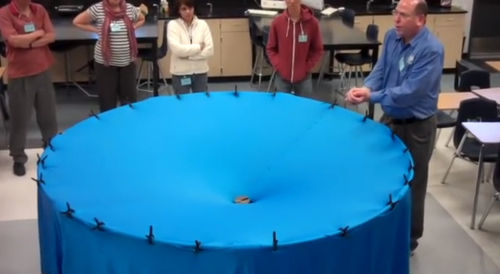
When you place an object on the fabric, the cloth curves. This is exactly what happens in the solar system as well.

The sun with such a huge mass bends the space-time fabric. And the earth and all the planets are kept in orbit by following this curvature that has been made by the sun.
Attributing to the various masses of objects, the way they bend this fabric also varies.
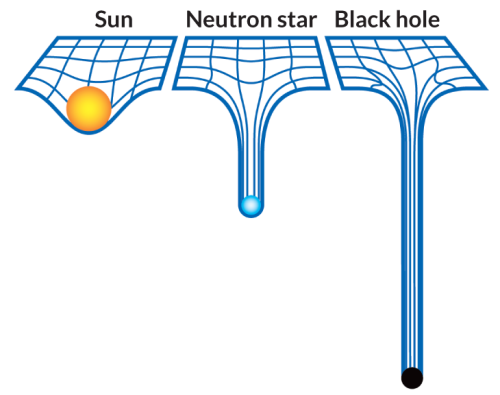
What are Gravitational Waves?
If you drop an object in a medium such as water, they produce ripples that propagate as waves through the medium.

Similarly, Gravitational waves are ripples in space-time fabric produced when you drag heavy objects through space time.
And the nature of these waves is that they don’t require a medium to propagate.
How do you make one?
Everything with mass/energy can create these waves.

Source
Two persons dancing around each other in space too can create gravitational waves. But the waves would be extremely faint.
You need something big and massive accelerating through space-time in order to even detect them.

And orbiting binary stars/black holes are valuable in this retrospect.
How can you detect them?
Let’s turn to the problem to detecting them assuming you do find binary stars/black-holes in the wondrous space to suite your needs.
Well, for starters you cannot use rocks/ rulers to measure them because as the space expands and contracts, so do the rocks. ( the distances will remain same in both the cases )

Here’s where the high school fact that the speed of Light is a constant no matter what plays an important and pivotal role.
If the space expands, the time taken for light to reach from A to B would be longer. And if it contracts, the time taken for it to reach from A to B would be smaller.

PC: PHDComics
By allowing the light waves from the contraction and expansion to interfere with each other, such as done in any interferometry experiment we can detect the expansion or contraction. Voila!
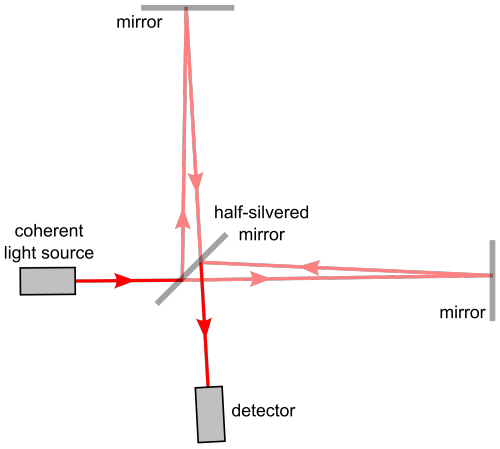
And this is exactly what they did! ( on a macroscopic level ) at LIGO (Laser Interferometer Gravitational-Wave Observatory)
14 September 2015

Two Black Holes with masses of 29 and 36 solar masses merged together some 1.3 Billion light years away.
Two Black Holes colliding is the header animation of the ‘Black Holes are not so Black Series’, in case if you haven’t noticed.

The merger of these two black holes results in the emission of energy equivalent to 3 solar masses as Gravitational Waves.
This signal was seen by both LIGO detectors, in Livingston and Hanford, with a time difference of 7 milliseconds.
And with the measurement of this time difference, physicists have pronounced the existence of Gravitational Waves.
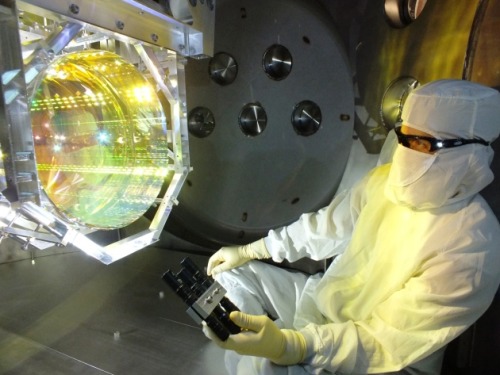
Source
All this is most certainly easily said than done and requires meticulous and extensive research, not to mention highly sensitive instruments.
Had they not have measured this time difference, we might have had to wait for the merger for more massive black holes to collide and maybe even build more sensitive instruments to detect these waves.
And Einstein predicted this a 100 years back!

Mind Blown!
Note: Hope you are able to understand and appreciate the profundity of the discovery done by mankind.
** All animations used here are merely for Educational purposes. If you have any issues, please write to us at : 153armstrong@gmail.com
(CNN) On October 19, the Pan-STARRS 1 telescope in Hawaii spotted something strange zooming through our solar system. It turned out to be a visitor from beyond our solar system, and it's unlike anything astronomers have seen before.
-
 liathepenguinologist reblogged this · 2 years ago
liathepenguinologist reblogged this · 2 years ago -
 theconstellationsinyourskin liked this · 2 years ago
theconstellationsinyourskin liked this · 2 years ago -
 liathepenguinologist reblogged this · 2 years ago
liathepenguinologist reblogged this · 2 years ago -
 liathepenguinologist liked this · 2 years ago
liathepenguinologist liked this · 2 years ago -
 atlashotep-blog-blog liked this · 3 years ago
atlashotep-blog-blog liked this · 3 years ago -
 rosebella2016 liked this · 3 years ago
rosebella2016 liked this · 3 years ago -
 ryrysofly liked this · 5 years ago
ryrysofly liked this · 5 years ago -
 devilinaraindrop liked this · 5 years ago
devilinaraindrop liked this · 5 years ago -
 sprout-god reblogged this · 6 years ago
sprout-god reblogged this · 6 years ago -
 naiadbookworm reblogged this · 6 years ago
naiadbookworm reblogged this · 6 years ago -
 roachregent liked this · 6 years ago
roachregent liked this · 6 years ago -
 alightinthedarkest reblogged this · 6 years ago
alightinthedarkest reblogged this · 6 years ago -
 the-thighlander liked this · 6 years ago
the-thighlander liked this · 6 years ago -
 wheresthings liked this · 6 years ago
wheresthings liked this · 6 years ago -
 gulsahcetin liked this · 6 years ago
gulsahcetin liked this · 6 years ago -
 baddest-bitch-of-the-west liked this · 6 years ago
baddest-bitch-of-the-west liked this · 6 years ago -
 wolfpetal5 liked this · 6 years ago
wolfpetal5 liked this · 6 years ago -
 reinedutemps reblogged this · 6 years ago
reinedutemps reblogged this · 6 years ago -
 of-fathoms-below liked this · 6 years ago
of-fathoms-below liked this · 6 years ago -
 spycopoth liked this · 6 years ago
spycopoth liked this · 6 years ago -
 lemongrappler reblogged this · 6 years ago
lemongrappler reblogged this · 6 years ago -
 chickadeedays liked this · 6 years ago
chickadeedays liked this · 6 years ago -
 peachcobblr reblogged this · 6 years ago
peachcobblr reblogged this · 6 years ago -
 lamaggiefangirl reblogged this · 6 years ago
lamaggiefangirl reblogged this · 6 years ago -
 the-hugs-are-here reblogged this · 6 years ago
the-hugs-are-here reblogged this · 6 years ago -
 the-hugs-are-here liked this · 6 years ago
the-hugs-are-here liked this · 6 years ago -
 emsails liked this · 6 years ago
emsails liked this · 6 years ago -
 manicpixiedust reblogged this · 6 years ago
manicpixiedust reblogged this · 6 years ago -
 jalkori reblogged this · 6 years ago
jalkori reblogged this · 6 years ago -
 jalkori liked this · 6 years ago
jalkori liked this · 6 years ago -
 rayndragon liked this · 6 years ago
rayndragon liked this · 6 years ago -
 what-the-bleeep reblogged this · 6 years ago
what-the-bleeep reblogged this · 6 years ago -
 what-the-bleeep liked this · 6 years ago
what-the-bleeep liked this · 6 years ago -
 skygazingphilosopher liked this · 6 years ago
skygazingphilosopher liked this · 6 years ago -
 your-royal-thickness liked this · 6 years ago
your-royal-thickness liked this · 6 years ago -
 tanenwa liked this · 6 years ago
tanenwa liked this · 6 years ago -
 plot-twist-im-lesbian liked this · 6 years ago
plot-twist-im-lesbian liked this · 6 years ago -
 shangela-stormborn reblogged this · 6 years ago
shangela-stormborn reblogged this · 6 years ago -
 sn1zzy2 liked this · 6 years ago
sn1zzy2 liked this · 6 years ago -
 mx5april liked this · 6 years ago
mx5april liked this · 6 years ago -
 demiannabeth reblogged this · 6 years ago
demiannabeth reblogged this · 6 years ago -
 therealcryptidismygender liked this · 6 years ago
therealcryptidismygender liked this · 6 years ago -
 demiannabeth liked this · 6 years ago
demiannabeth liked this · 6 years ago -
 zenadus liked this · 6 years ago
zenadus liked this · 6 years ago -
 universalbang reblogged this · 6 years ago
universalbang reblogged this · 6 years ago -
 universalbang liked this · 6 years ago
universalbang liked this · 6 years ago
For more content, Click Here and experience this XYHor in its entirety!Space...the Final Frontier. Let's boldly go where few have gone before with XYHor: Space: Astronomy & Spacefaring: the collection of the latest finds and science behind exploring our solar system, how we'll get there and what we need to be prepared for!
128 posts